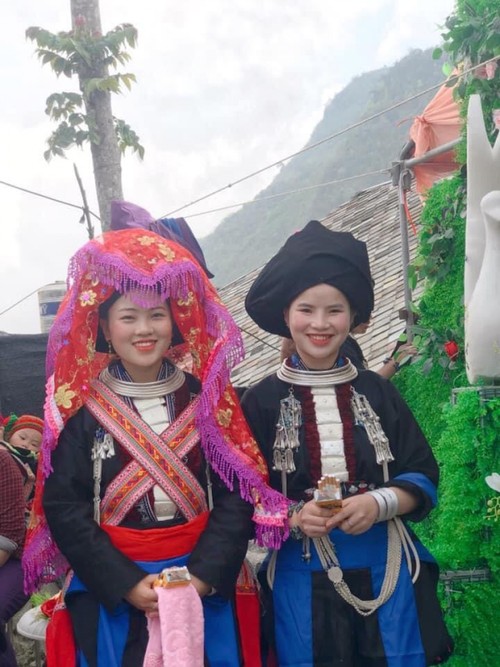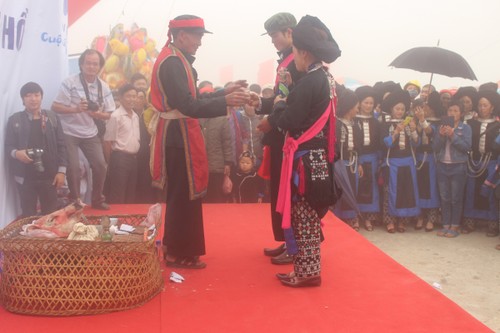 A Dao bride and her bridesmaid. (Photo: VOV) A Dao bride and her bridesmaid. (Photo: VOV) |
The kowtowing ritual usually takes place between 7pm and midnight on the wedding day. The groom sets up a square table near the altar in the main hall, and places three benches on three sides of the table. On the table he sets a bowl of rice with two flowers on it, a piece of boiled pork, two large trays, 8 to 10 pairs of chopsticks, 8 to 10 glasses, and 100 kernels of corn. Straw is spread on the floor in front of the table and on the straw are two mats and two folded blankets for the bride and the groom to kneel on.
Before the ceremony, 12 boys and 12 girls sit on the benches and symbolically eat and drink. A band plays a cheerful tune to enliven the atmosphere.
“The bride wears a wedding gown and drapes two red ribbons over her shoulders and ties them to a flower at her waist. The rest of the ribbons trail on the ground. A shorter red cloth is wrapped around her waist and tied at the back with the two loose ends hanging down to her heels. She wears on her head a thin trapezoid of wood decorated with red beaded tassels, which is covered with an embroidered red cloth,” said Tan My Xoang, a match maker in Ta Phin commune.
“The bride wears this costume from her house to the groom’s house before the kowtowing ceremony. The groom wears a long indigo robe, a red flower-ribbon like the bride’s, and pins a flower to a red scarf over his forehead,” Xoang added.
 The master of ceremonies declares the couple husband and wife. (Photo: VOV) The master of ceremonies declares the couple husband and wife. (Photo: VOV)
|
When the bride and groom have taken their place at the left front of the altar, the ritual begins. Two bridesmaids help the bride kneel and stand beside the groom at the signal of a master of ceremonies, who indicates when people should sit at the table to receive the couple’s kowtow, how many times to kowtow, and what music should accompany each part of the ceremony.
“The groom holds a handkerchief in his right hand. He stretches his arms out, clasps his hands in front of his chest, raises his arms to his forehead, bends his head and arms, raises his head up, drops his hands to his sides, and stands with his back straight. The groom and bride perform three rounds of standing kowtows and three rounds of kneeling kowtows for their ancestors, parents, and guests,” said Tan A San of Phang Xo Lin commune, who often invited to be the master of ceremonies.
The first round of kowtows is to the ancestors. The master of ceremonies has the couple do 7 kowtows while the band plays a special tune.
The second round is dedicated to the couple’s parents. After they finish kowtowing, their parents put some lucky money on the tray on the table, eat a piece of pork, and leave the table.
The last round of kowtows is to the guests, who include relatives, friends, and neighbors. The guests must be married people.
When the kowtowing ritual ends, the master of ceremonies declares the couple husband and wife, and advises them to remember the merits of their parents for giving birth to them and raising them, to lead a virtuous life, and to work hard. He ends by wishing them eternal love and happiness.